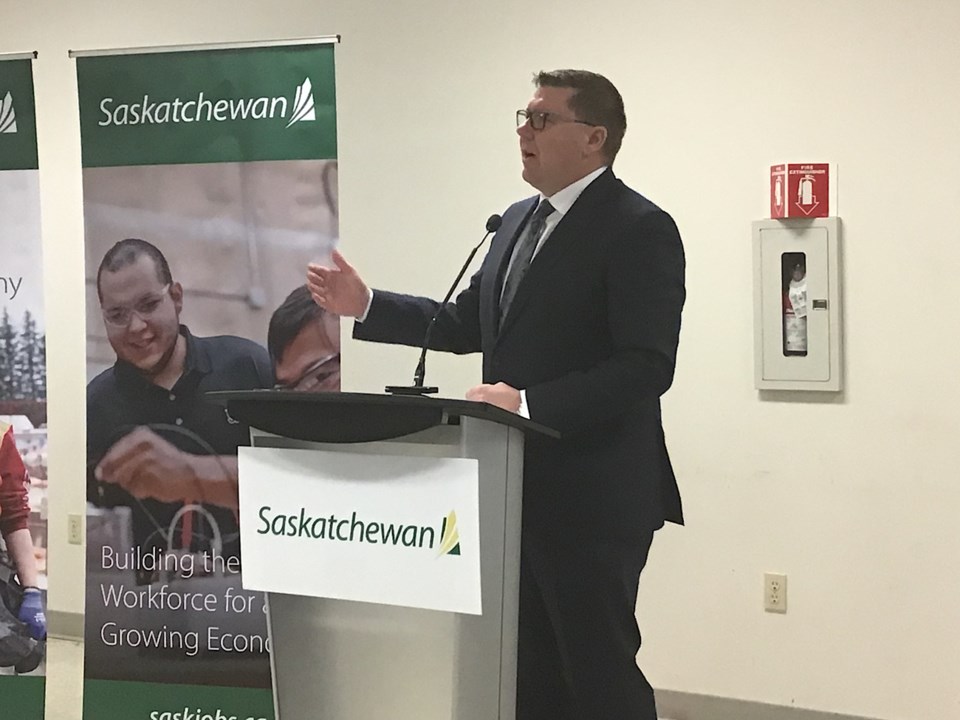REGINA - In an announcement Monday, provincial officials have unveiled the province's approach to prepare for current and future labour needs and growth.
The plan is titled Building the Workforce for a Growing Economy: the Saskatchewan Labour Market Strategy. Premier Scott Moe made the announcement at Young’s Equipment in Regina, along with Trade and Export Development Minister Jeremy Harrison. In that speech Moe pointed to what the government had heard from employers, saying this strategy “is all of us working together to fulfil the labour market requirements we have today as well as looking at tomorrow. This strategy outlines provincial investments in programs and in services and partnerships that align Saskatchewan’s workforce with the evolving needs that we see coming in the industry.”
Three main pillars are outlined in the Labour Market Strategy:
1. Preparing Saskatchewan People for Jobs:
Moe said this pillar outlines that “people who live here today should always have the first chance to benefit from the opportunities our growing economy presents, and that’s paramount.”
He pointed to the 10 SaskJobs offices in the province offering employment counselling and helping with jobs searches. The province is also looking to increase Indigenous participation in the labour force through targeted support programs, and is also looking to reduce barriers for persons with disabilities.
2. Recognizing Skills in Saskatchewan:
As part of the strategy, Saskatchewan is investing $2 million in credentials recognition support so people who already are present in the province can work in fields in which they already are trained.
“It’s important to remember these are people with those skills that are present in the province. It’s unacceptable, for example, to have whether it be across Canada or internationally trained healthcare workers or tradespeople or engineers that are unable to practice their profession in this province.”
He said Saskatchewan is taking steps to cut through the red tape — “how often do you hear the government is cutting though the red tape,” Moe said — to quickly and efficiently recognize credentials obtained either elsewhere in Canada or elsewhere in the world.
He said through legislation passed a year ago, there are now mandatory timelines for all regulatory bodies when assessing credential, recognition application to come to them. Moe called it the “most ambitious” and “most forward thinking approach” to credential recognition in Canada.
It was also noted that the province would be communicating very soon on how they will help people navigate the credential recognition system in Canada.
3. International Recruitment:
Premier Moe said immigration and international recruitment will remain important. He said the Saskatchewan Immigrant Nominee Program will receive an additional 8,500 applicants by next year.
Moe added the province is investing in what he described as a “very innovative” retention program so that the talented newcomers to Saskatchewan continue to build their lives in Saskatchewan.
“We need to be responsive on what the labour market needs are going to be today and what those labour market needs are going to be tomorrow.”
Premier Moe described the Labour Market Strategy as “a roadmap, using where we came from, taking that information and applying it to the next 5 and 10 and 15 and 20 years, a roadmap to success for this industry, roadmap to success for the industries that are operating across Saskatchewan, and ultimately a roadmap to success for all the people who live here today, and the opportunities that they will have tomorrow, as well as the people who are on their way.”
Moe pointed to these efforts as 小蓝视频 in line with the growth program that the government had put forward to add 100,000 jobs by 2030 -- a goal he expressed confidence Saskatchewan would reach.
“I think we’re going to be able to attain that, we’re on track to attain that and likely, like many of the other targets have the opportunity to attain it far before 2030.”
Sean Young, Assistant General Manager of Young’s Equipment, told reporters he welcomed the announcement from the province.
“As an industry, we’re facing a shortage in a number of different positions - technicians, parts people, and we know that the labour force in Saskatchewan needs to continue to grow. There needs to be continued investment in education, in skill training in the trades, and so anything that furthers that is something that we fully support and I think that’s going to help us continue to serve the province’s primary agriculture producers better as an industry.”






